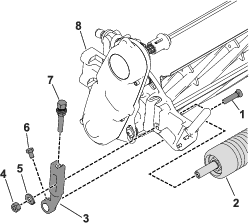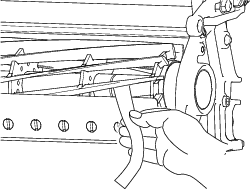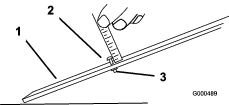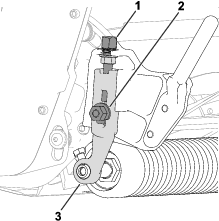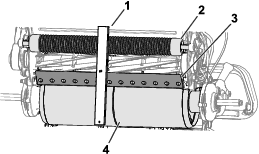Maintenance
Note: Determine the left and right sides of the machine from the normal operating position.
Checking the Reel-Driveshaft Grease Point
| Maintenance Service Interval | Maintenance Procedure |
|---|---|
| Yearly |
|
-
Remove the hardware that secures the reel-drive assembly to the side plate (Figure 12).
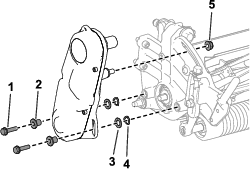
-
Remove the reel-drive assembly, flat washers, spring washers, and spacers from the side plate (Figure 12).
-
Check the inside of the reel driveshaft (Figure 13) for any remaining grease.
If you do not see a sufficient amount of grease, add more grease to the male and female spline shaft.
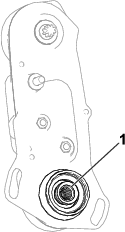
-
Use the previously removed socket-head screws, washers, and spacers to secure the reel-drive assembly to the side plate.
-
Install the cutting unit to the traction unit; refer to your traction unit Operator’s Manual.
Servicing the Bedbar
Only a properly trained mechanic should service the bedbar and bedknife to prevent damage to the reel, bedbar, or bedknife. Ideally, take the cutting unit to your authorized Toro distributor for service. Refer to the Service Manual for your traction unit for complete instructions, special tools, and diagrams for servicing the bedknife. Should you ever need to remove or assemble the bedbar yourself, instructions are provided below, as are the specifications for servicing the bedknife.
Important: Always follow the bedknife procedures detailed in your Service Manual when servicing the bedknife. Failure to install and grind the bedknife correctly can lead to damage to the reel, bedbar, or bedknife.
Removing the Bedbar
-
Turn the bedbar adjusting-screw counterclockwise to back the bedknife away from the reel (Figure 14).
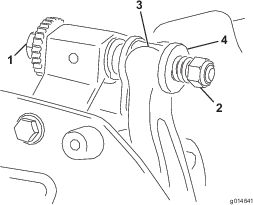
-
Back out the spring-tension nut until the washer is no longer tensioned against the bedbar (Figure 14).
-
On each side of the machine, loosen the locknut shown in Figure 15.
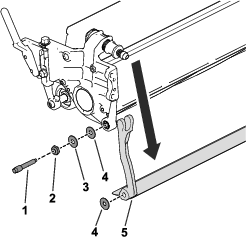
-
Remove each bedbar bolt, allowing the bedbar to be pulled downward and removed from the cutting unit (Figure 15).
Account for the 2 steel washers and 1 plastic washer on each end of the bedbar (Figure 15).
Installing the Bedbar
-
Install the bedbar, positioning the mounting ears between the washers and the bedbar-adjusting screw (Figure 14).
Important: Center the DPA adjusters in the bedbar ears as shown in Figure 16.If DPA adjusters are installed against the bedbar ears, this may negatively affect the bedknife-to-reel contact.

-
Secure the bedbar to each side plate with the bedbar bolts (nuts on bolts) and 3 washers (6 total).
-
Position a nylon washer on each side of the side-plate boss. Place a steel washer outside each of the nylon washers (Figure 17).
-
Torque the bedbar bolts to 27 to 36 N∙m (240 to 320 inch-lb).
-
Tighten the locknuts until you remove the end play from steel washers, but you are able to rotate them by hand. The washers on the inside may have a gap.
Important: Do not overtighten the locknuts or they will deflect the side plates.
-
Tighten the spring tension nut until the spring is collapsed, then back it off 1/2 turn (Figure 17).
-
Adjust the bedknife to the reel; refer to Adjusting the Bedknife to the Reel.
Adjusting the Clip Rate
The clip rate is determined by the following machine settings:
-
Reel speed: The reel speed can be adjusted to a high or low setting; refer to your traction unit Operator’s Manual.
-
Reel-drive-pulley position: The reel-drive pulleys (22-tooth and 24-tooth) can be set in 2 positions:
Note: The pulley position is set to the LOW position from the factory.

To adjust the position of the pulleys, refer to the following steps:
-
Remove the belt cover to expose the belt (Figure 19).
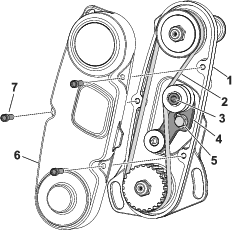
-
Loosen the idler-arm bolt and rotate the idler arm (Figure 19) to release tension on the belt.
-
Remove the belt (Figure 19).
-
Loosen the nut on each pulley, remove the pulleys, and use the nuts to install the pulleys in your desired configuration.
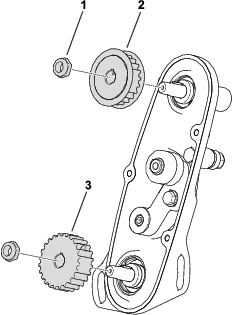
-
Torque the pulley nuts to 37 to 45 N∙m (27 to 33 ft-lb)
-
Install the belt and tension the belt by applying 6 to 7 N∙m (55 to 60 in-lb) to the idler-arm internal hex shown in Figure 19.
-
Tighten the idler-arm bolt and install the belt cover.
Adjusting the Grass Shield
Adjust the grass shield to ensure that the clippings are cleanly discharged from the reel area, as follows:
Note: The shield is adjustable to compensate for changes in turf conditions. Adjust the shield closer to the reel when the turf is extremely dry. By contrast, adjust the shield further away from the reel when the turf conditions are wet. The shield should be parallel to the reel to ensure optimum performance. Adjust it after the reel is sharpened on a reel grinder.
-
Loosen the screws that secure the grass shield (Figure 21) to the cutting unit.
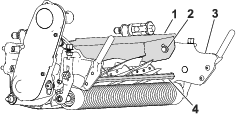
-
Insert a 1.5 mm (0.060 inch) feeler gauge between the top of the reel and the shield, then tighten the screws.
Important: Ensure that the shield and reel are an equal distance apart across the entire reel.
Note: Adjust the gap as needed for your turf conditions.
Bedknife Specifications
Installing the Bedknife
-
Remove the rust, scale, and corrosion from the bedbar surface and apply a thin layer of oil to the bedbar surface.
-
Clean the screw threads.
-
Apply anti-seize compound to the screws and install the bedknife to the bedbar.
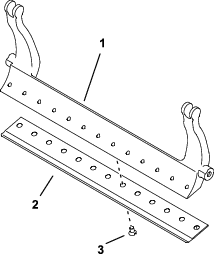
-
Torque the 2 outer screws to 1 N∙m (10 in-lb).
-
Working from the center of the bedknife, torque the screws to 23 to 28 N∙m (200 to 250 in-lb).
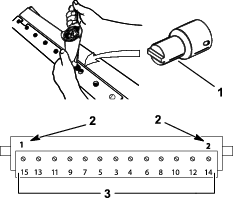
-
Grind the bedknife.
Bedknife Grinding Specifications

| Bedknife Relief (Top) Angle | See Height-of-Cut and Bedknife Selection Charts. |
| Front Angle Range | 13° to 17° |
| Fairway Bedknife Front Angle | 10° |
Checking the Top Grind Angle
The angle that you use to grind your bedknives is very important.
Use the angle indicator (Toro Part No. 131-6828) and the angle-indicator mount (Toro Part No. 131-6829) to check the angle that your grinder produces and then correct for any grinder inaccuracy.
-
Place the angle indicator on the bottom side of the bedknife as shown in Figure 25.
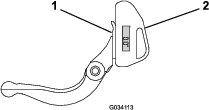
-
Press the Alt Zero button on the angle indicator.
-
Place the angle-indicator mount on the edge of the bedknife so that the edge of the magnet mates with the edge of the bedknife (Figure 26).
Note: The digital display should be visible from the same side during this step as it was in step 1.

-
Place the angle indicator on the mount as shown in Figure 26.
Note: This is the angle that your grinder produces, and should be within 2 degrees of the recommended top grind angle.
Reel Specifications
Preparing the Reel for Grinding
-
Ensure that all cutting unit components are in good condition and correct any issues before grinding.
-
Follow the reel grinder manufacturer’s instructions to grind the cutting reel to the following specifications.
Reel Grinding Specifications New Reel Diameter 128.5 mm (5.06 inches) Reel Diameter Service Limit 114.3 mm (4.50 inches) Blade Relief Angle 30° ± 5° Blade Land Width Range 0.8 to 1.2 mm (0.03 to 0.05 inches) Reel Diameter Taper Service Limit 0.25 mm (0.010 inch)
Relief-Grinding the Reel
The new reel has a land width of 1.3 to 1.5 mm (0.030 to 0.050 inch) and a 30° relief grind.
When the land width gets larger than 3 mm (0.120 inch) wide, do the following:
-
Apply a 30° relief grind on all reel blades until the land width is 0.8 mm (0.03 inch) wide (Figure 27).
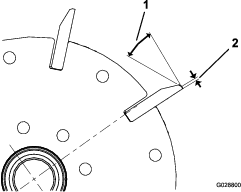
-
Spin grind the reel to achieve <0.025 mm (0.001 inch) reel run-out.
Note: This causes the land width to grow slightly.
-
Adjust the cutting unit; refer to your cutting unit Operator’s Manual.
Note: To extend the longevity of the sharpness of the edge of the reel and the bedknife—after grinding the reel and/or the bedknife—check the reel to bedknife contact again after cutting 2 greens, as any burrs will be removed. Burrs may create improper reel to bedknife clearance, which can accelerate wear.
Backlapping the Cutting Unit
To backlap the cutting unit, use the Access Backlap Kit (Model No. 139-4342) or the Backlap Kit (Model No. 04800); refer to the operating instructions in the kit Installation Instructions. Contact your authorized Toro distributor to acquire one of these kits.
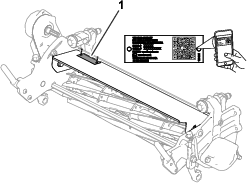

 , which means Caution, Warning,
or Danger—personal safety instruction. Failure to comply with
these instructions may result in personal injury or death.
, which means Caution, Warning,
or Danger—personal safety instruction. Failure to comply with
these instructions may result in personal injury or death.


